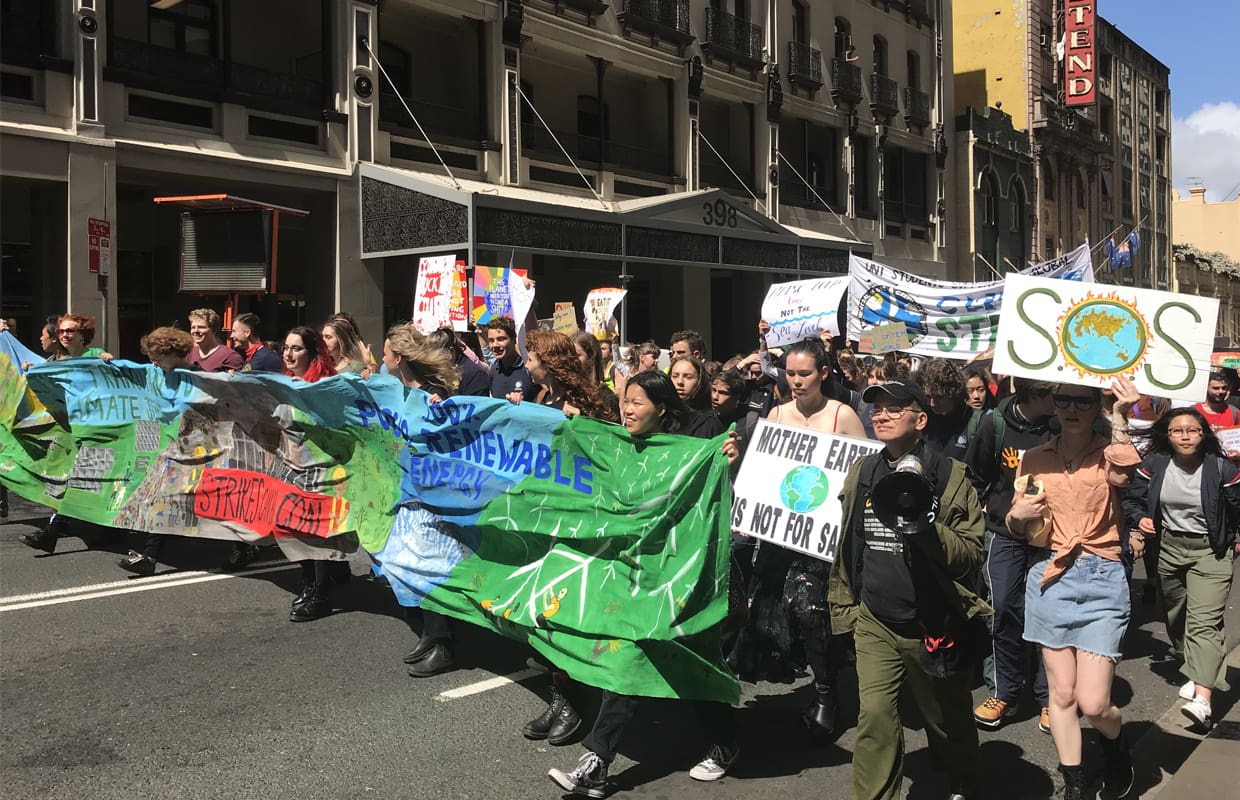I heard their voices first, a murmur predicating a crowd whose footsteps and loudspeaker chants intensified as they sprawled over Eastern Avenue. Spearheaded by a banner held barely unfurled between six students, I watched the 2000-strong contingent of USyd’s staff and students as they turned onto City Road, awestruck by its size and the collective excitement that engulfed my hesitation at skipping class.
Just before the march I met with Professor Dee Carter, the Head of Microbiology, whose faculty had cancelled all its classes for the strike, to discuss the impact of the climate crisis on human health. She highlighted how the rising global temperature and increasing number of natural disasters would leave us “much more vulnerable to fungal, bacterial and parasitic infections.”
In her field of fungal biology specifically, fungi are learning to adapt to warmer temperatures, such that our body temperatures could become insufficient to inhibit their growth. Combined with the challenge of developing new drugs to bolster the few available for treating fungal infections, this could lead to higher rates of infection and mortality. Already, a case of the multi-drug-resistant fungus Candida auris has emerged in Victoria, with a 30-day mortality rate of over 35.2%.
“There’s a desperate need for new drugs, and there’s not enough research and funding going on to bring them into the mainstream pipelines,” Professor Carter said. “We are running out of existing drugs and options.”
But other microbiological advances could play an important role in mitigating the crisis. Research on renewable algae-based biofuels is underway, as algae can remove carbon dioxide, a major contributor to climate change, and convert it into lipids and oils to be used as fuel. There is also interest in using fungi to break down and convert wood into fuels.
Professor Carter expressed concern about climate change sceptics, particularly in governments. “Parts of the world are listening to us, and parts of the world aren’t, that’s the problem.” She advised arguing for change “from a values base rather than an evidence base” as “it’s quite difficult, actually, to persuade people with evidence. People will just get more and more entrenched in their views once you start arguing with them.”
As a professor, she hopes to teach students to think critically, analyse the data, and think for themselves, and her advice for science students was to “get out there and tell the government what you think. You’re young people, it’s your future. You’ve got to act now.”
With her words in mind, I joined the crowd, comprising people of all ages and backgrounds, which swelled at its convergence point in front of UTS. As we walked through Sydney, I wove between chant leaders, bearers of irreverent placards, and even the elusive yeti. On passing a lone counter-protester, whose slogan was, “CO2 is plant food! The more CO2, the healthier our plants,” even high schoolers shook their heads in disbelief. Upon arrival at The Domain, I was again shocked by just how many people had shown up; the area surrounding the stage looked like a fishbowl brimming with people, and the speeches given by the student activists drew roars of support and galvanised the crowd. I left feeling elated that I had been there, expressed my views and seen the force of the student-led movement.
But my following interview with Professor Manfred Lenzen from the Integrated Sustainability Analysis Team at USyd was much more sobering. His work on consumption-based accounting of greenhouse gas emissions, which allows people to see the carbon footprint of the food and products they consume, has highlighted the need for high-income countries to reduce their greenhouse gas emissions to even lower levels than those recommended by international agencies, such as the Intergovernmental Panel on Climate Change (IPCC).
“Emissions cannot be halved uniformly by 2030. Some nations already emit half of the target, and we cannot ask them to halve that… this global, uniform 50% reduction target actually translates in Australia and [other high-emission countries] not to reduce by 50%, but by 80%.”
But what would an 80% reduction look like? “Energy consumption went down by 5% during the Global Financial Crisis, by 30% during the Great Depression, and by 50% in Japan and Germany at the end of WWII. All of this doesn’t come close to the 80% reduction [which would result in] such fundamental changes to [our] lives that [we] cannot imagine.”
Additionally, there are psychological and political complications behind making these changes; Professor Lenzen stresses that it is easier for people to “shut down” than to process the extent of the personal sacrifices needed, and politically, no government could enforce these. While supportive of the climate strike’s demand for a transition to 100% renewable energy by 2030, he cautioned against “creat[ing] a false sense of security that doing this is all it takes… in order not to overwhelm people, you [would fall] woefully short of what is really needed to deal with the problem.”
While the scale of the problem and our personal responsibility to resolve it may be incomprehensible to us, perhaps we should direct our attention to what we can comprehend; to more urgently cut back on our greenhouse gas emissions, pursue new technological means of removing and reducing them, and better prepare for natural disasters and their associated health challenges ahead. Even if all we can do is to delay experiencing the full effects of the climate crisis, we could at least say that we tried.
Raising my voice and hearing it amongst thousands of others at the strike made me realise the unifying potential of the climate change issue, and how its resolution would only be possible with a widespread commitment to action, larger than the act of protest I was participating in. Whether this personal, social and political commitment can be made globally and enacted before we bear the brunt of the climate crisis is something we should not wait to find out.
Coco Huang is a second year Bachelor of Science/Bachelor of Advanced Studies (Medical Science) student.





